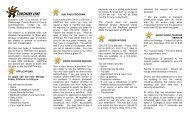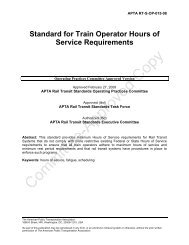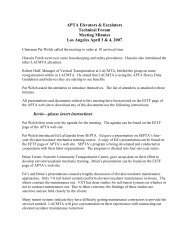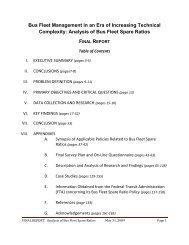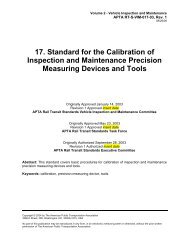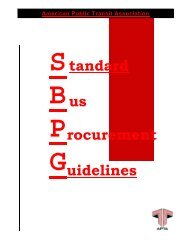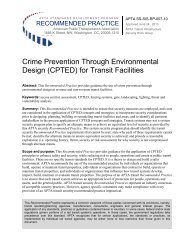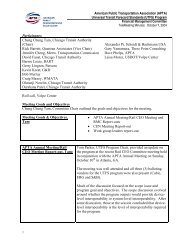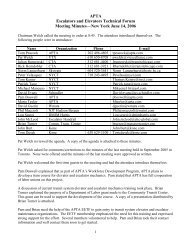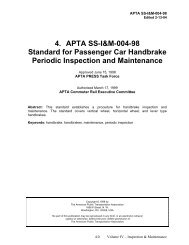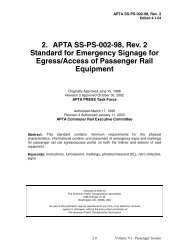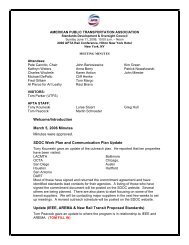Standard for Rail Transit Grade Crossing Warning Systems for Rail ...
Standard for Rail Transit Grade Crossing Warning Systems for Rail ...
Standard for Rail Transit Grade Crossing Warning Systems for Rail ...
You also want an ePaper? Increase the reach of your titles
YUMPU automatically turns print PDFs into web optimized ePapers that Google loves.
systems and two (2) and four (4) quadrant gate systems..<br />
4.1.1 <strong>Warning</strong> time<br />
Volume 3 - <strong>Rail</strong> <strong>Grade</strong> <strong>Crossing</strong>s Rev. 1<br />
APTA RT-S-RGC-004-03<br />
12/08/05<br />
Highway rail grade crossing warning systems shall be maintained to operate in compliance with<br />
the design of the warning system, but in no event shall they provide less than 20 seconds warning<br />
time <strong>for</strong> the operation of through trains be<strong>for</strong>e grade crossings are occupied by rail traffic.<br />
Alternative warning times may be authorized by the RTS <strong>for</strong> special conditions such as near-side<br />
station stops. For these conditions, the train operator shall be able to stop the train prior to<br />
entering the intersection until it is verified that the warning system is active, and if so equipped,<br />
gates are in the fully horizontal position, and that the intersection is clear of highway and/or<br />
pedestrian traffic.<br />
4.1.2 Near-side station stops<br />
Operation of grade crossing warning systems may be delayed or bypassed <strong>for</strong> near-side station<br />
stops under any of the following conditions:<br />
a) <strong>Transit</strong> Authority operating rules require that all trains (or other vehicles normally<br />
causing the warning system to operate) shall stop at the station. This includes stopping<br />
<strong>for</strong> the minimum dwell time if so designed, OR;<br />
b) Vital functions are used to identify trains that must stop at the station by operating rule,<br />
OR;<br />
c) For locations equipped with crossing gates, vital functions (implemented by a signal or<br />
train control system) shall provide a warning and/or prevent the train from entering the<br />
crossing until the gates are down.<br />
Where electronic or processor-based systems are used, they shall con<strong>for</strong>m to AREMA Signal<br />
Manual, Part 17.3 and/or IEEE Std. 1483-2000.<br />
Where near side station stops are adjacent to interconnected traffic signal controlled<br />
intersections, accommodations must be made to ensure adequate pedestrian and vehicle<br />
clearance intervals.<br />
4.1.3 Audible warning devices<br />
Each active crossing warning system shall be equipped with no less than one (1) crossing bell or<br />
other audible warning system in compliance with state requirements. Each bell shall con<strong>for</strong>m to<br />
AREMA Signal Manual 3.1.15.E.8, 3.2.60 & 61. Additional ancillary audible devices may be<br />
used at the rail transit system’s discretion.<br />
4.1.4 Interconnection circuits<br />
Interconnection circuits between highway traffic signals and highway rail grade crossing<br />
warning systems shall con<strong>for</strong>m to AREMA Signal Manual Part 3.1.10. and Part 16.30.10. Serial<br />
communication interconnects shall also con<strong>for</strong>m to IEEE Std. 1570-2002.<br />
Copyright © 2004 APTA. All rights reserved. 4.6



